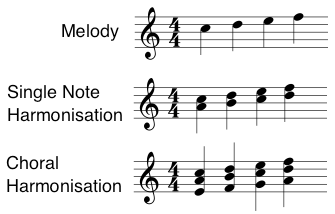Introduction
A melody is the main voice that is heard on top of every other musical element (percussion, chords, etc.). Harmonisation is the process of adding a chordal accompaniment to the melody. This can be done:
- By adding a chord progression under the melody; or
- By playing one or more notes with the melody (so playing two or more notes at once).
This latter method harmonises every melody note with a chord or implied quasi-chord. We will come back to this topic when we discuss ‘Locked Hands Voicings‘ and ‘Reharmonization‘.
Harmonisation
For the moment, all you need to know is that in Western Music 3rds and 6ths are usually used to harmonise a melody.

For example, if you’re in the key of C Major and the melody note is C, you can harmonise it by playing an E (Major 3rd) or an A (Major 6th). Or, if you’re in the key of C natural minor and the melody note is C, you can harmonise it by playing an E♭ (minor 3rd) or an A♭ (minor 6th). Though you can just as easily harmonise a melody line using any interval. Intervals other than the 3rd and the 6th, however, will sound more antiquated or dissonant.